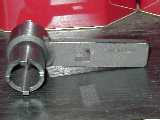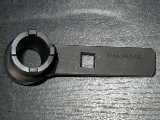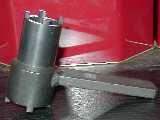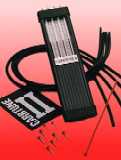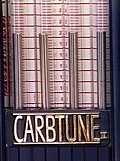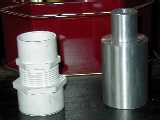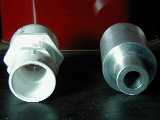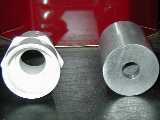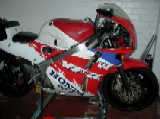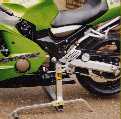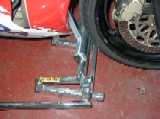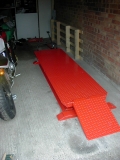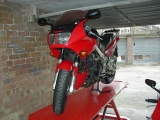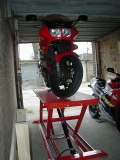Workshop Tools
Most service and mechanical tasks on Honda V-4s can be accomplished with a normal set of tools. But certain specialized tools can make some jobs easier, or could even save an otherwise necessary trip to the local dealer's service department. Described below are a few of these specialized tools:
PIVOT LOCK NUT WRENCH
This tool is used to remove, install and properly torque the swing arm pivot bolts on VFRs and certain other modern Hondas, including the NC29. The same tool is also used for the some of the rear engine mounting bolts on VFRs and other Hondas. This is the Honda tool, but specialty tool manufacturers such as KOWA and K&L also make similar tools—not sure if anyone apart from Honda makes ones with the proper offset for the torque wrench, though. As noted in a "Tool Tip" in the Haynes service and repair manuals, the mounting bolt lock nuts can be removed and installed using a fabricated "peg spanner" made from an old 22mm socket, or from 30mm O.D. steel tubing, but the proper torque cannot be applied to the lock nut without the special tool.
The tool is available only from Honda dealers, under part number 07HMA-MR70200, and lists for $66.50 in the U.S. Oddly, this is not the part number listed in the Honda VFR750F Service Manual (07908-4690002) and which Honda dealers were consistently unable to locate. The offset 1/2" socket drive is located 50mm from the center of the tool, and (supposedly) the torque figures given in the Service Manual have been calculated with the 50mm offset of the tool in mind. The tool's other dimensions are: 32mm O.D. on one end; 40mm O.D. on the other end; and the I.D. is 24mm.
CARBURETOR SYNCHRONIZING TOOLS
Once you've courageously decided to synch your VFR's carburetors and purchased a set of vacuum gauges for that purpose, you will soon notice one small problem related to the VFR's V-4 engine configuration: The carburetor throttle adjustment screws are located deep within the engine's "vee," where it is difficult to reach and where the engine gets very hot. Without a special tool with an 8mm angle drive on the end, you really need to remove the left side ignition coil bracket, wear gloves and arm protection and move quickly before the engine really heats up. This tool makes the adjustment process much simpler.
 |
Vacuum gauges now come in many configurations, including mercury gauges ("carb sticks"), electronic gauges, traditional round gauges and the VSource choice, the Morgan Carbtune-II mercury-free gauge. Any kind will work, though the cheap vacuum gauge sets can be very frustrating to use because the needles are very prone to fluctuating wildly (the expensive Davida gauges are another matter). Mercury requires careful handling, and the electronic ones are very expensive. The Carbtune-II uses steel rods instead of columns of mercury, and seems to be a high quality, sturdy tool with good accuracy. Formerly available only in the U.K., the Carbtune-II is now available from John Morgan for about $90, shipped to the U.S.¹
VFR WHEEL BALANCING ADAPTERS
Doing your own wheel balancing with a static balancer is not difficult if you have a balancing stand and a fistful of stick-on weights. But the VFR rear wheel requires an adapter—many Honda dealers don't even have the proper adapter to electronically balance VFR rear wheels (the RC36 rear wheel has four holes on a 100mm circle; the RC30/NC30/NC35 has four drive pins on an 85mm circle and a central "bolt" hole). There many adapters available, but two options on the less expensive side of the spectrum are shown below. The plastic adapter is made from two PVC Schedule 40 threaded pipe thread adapters (1 1/4" and 1") glued together and is sold as a unit by NoyzToyz for $10 (in addition to other Tireqwik products). The aluminum adapter (which took about five months to be delivered!) is sold by SPEC II for $40.¹
SERVICE STANDS
Working on motorcycles is a lot easier when the bike is on a service stand. (It's even easier on a motorcycle lift, but few of us can justify the expense of one of those! But...see below.) Due to the single sided sting arm, the inexpensive swing arm stands cannot be used, so most people buy a special kind of stand that fits into the hollow rear wheel hub. These are very convenient to use for basic service procedures, but for more involved tasks a better solution is a service stand that fits into the hollow swing arm pivot bolt, thus allowing rear suspension movement. Such stands are manufactured by ABBA and N.W.S in the UK. Shown below is the VSource.org NC30 sitting on two N.W.S stands:¹
The front stand, which suffers with the name "uP fRoNt," fits into the bottom of the bike's steering stem. Both work very well, with the Ulti-Pro being extremely stable, though a bit fiddly to fit.
BALCO B500M MOTORCYCLE LIFT
After working on motorbikes for years without a proper motorcycle lift, one was finally planned for, budgeted and sourced for the luxuriously expansive VSource.org workshop facilities. The Italian-made B500M lift can be seen on the Balco UK Web site.¹
Notes:
(No, VSource.org was not compensated in any way for these endorsements!)
 |
|
Copyright © VSource.org 1999-2005 |
